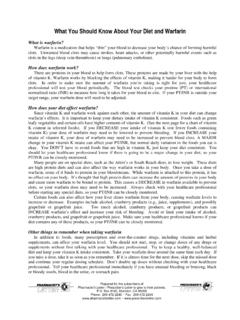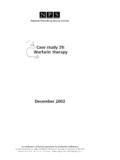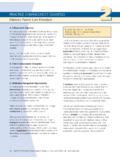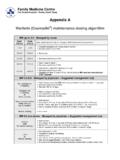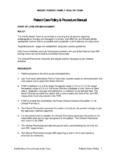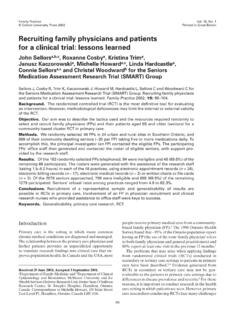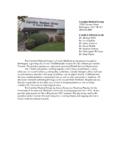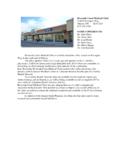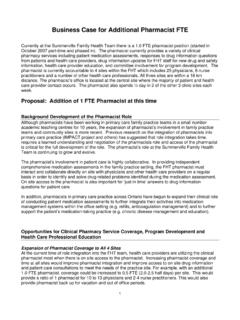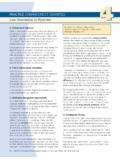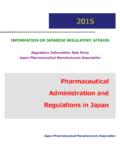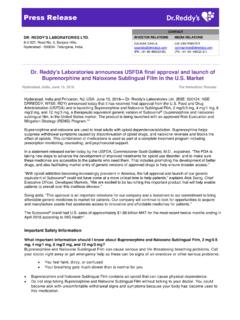Transcription of Integrating Family Medicine and Pharmacy to …
1 CliniCal pharmaCology & TherapeuTiCs | VOLUME 83 NUMBER 6 | JUNE 2008 913practicenature publishing groupIntegrating Family Medicine and Pharmacy to Advance Primary Care TherapeuticsL Dolovich1,2, K Pottie3 5, J Kaczorowski6 8, B Farrell3,5, Z Austin9, C Rodriguez1, K Gaebel1 and C Sellors2 The prevalence of suboptimal prescribing of medications is well ,2 Patients are often undertreated or not offered therapeutic treatments that are likely to confer ,4 As a result, drug-related hospital admissions are common and often Improvements to the health-care system are clearly needed in order to maximize the benefits that can be derived from medications.
2 Many countries are changing their primary health-care systems to improve the quality of health-care ,7 One main transformation is the use of multidisciplinary care teams to provide care in a coordinated manner often from the same location or by using the common medical record of the patients. It has been demonstrated that pharmacists can improve prescribing, reduce health-care utilization and medication costs, and contribute to clinical improvements in many chronic medical conditions, such as cardiovascular disease, diabetes, and psychiatric 11 However, the effect of Integrating a pharmacist providing general services into a primary care group has not been extensively studied.
3 The Integrating Family Medicine and Pharmacy to Advance Primary Care Therapeutics (IMPACT) project was designed to provide a real-world demonstration of the feasibility of Integrating the pharmacist into primary care office practice. This article provides a description of the IMPACT project participants; the IMPACT practice model and the concepts incorporated in its development; some initial results from the program evaluation; sustainability of the model; and some reflections on the implementation of the practice ProjeCT PArTICIPAnTsIMPACT was a demonstration project that placed a pharma-cist into each of seven Family medical practice sites across the province of Ontario, Canada.
4 The pharmacists worked 2 3 days a week starting 1 June 2004. They were selected through a struc-tured hiring process that emphasized communication and criti-cal thinking skills and a demonstrated willingness to encourage innovation in All the pharmacists had previously worked within a community setting, and also within a hospital or a long-term care setting. The seven Family medical practice sites included inner city, urban, and semirural locations. Six were community sites and one was a full academic site. In four of the sites, paper records were used, while the other three used electronic medical records.
5 The number of physicians ranged from 6 to 15 per PrACTICe ModelThe project practice model was composed of four components that were employed concurrently to foster integration and pro-mote optimal prescribing and use of medications (described in detail in Ta b l e 1). Training and support were provided to assist the pharmacist and others at the location to manage change. A 2-day training workshop was held for the pharmacists to assist them to transition into the unfamiliar environment of a busy Family practice. The workshop experience centered on the Family Practice Simulator, an interprofessional curricular innovation in which physicians, pharmacists, and other health-care profession-als work with standardized patients and carry out activities over the course of a typical day in Family Ongoing support was provided through a mentorship program.
6 Mentors provided emotional support, problem-solving advice, and assistance with developing clinical knowledge and skills. Each pharmacist had access to a provincial drug information center. The pharmacists were also provided with profiles of the medical practices at the relevant locations and a project implementation order to preserve the relationship and avoid fragmentation of care, the Family physician retained the lead role in diagnosing 1 Centre for Evaluation of Medicines, St. Joseph s Healthcare, Hamilton, Ontario, Canada; 2 Department of Family Medicine , McMaster University, Hamilton, Ontario, Canada; 3 lisabeth Bruy re Research Institute, Ottawa, Ontario, Canada; 4 Institute of Population Health, University of Ottawa, Ottawa, Ontario, Canada; 5 Department of Family Medicine , University of Ottawa, Ottawa, Ontario, Canada; 6 Primary Care and Community Research, Child & Family Research Institute, Vancouver, British Columbia, Canada.
7 7 Department of Family Practice, University of British Columbia, Vancouver, British Columbia, Canada; 8 Department of Health Care and Epidemiology, University of British Columbia, Vancouver, British Columbia, Canada; 9 Leslie Dan Faculty of Pharmacy , University of Toronto, Toronto, Ontario, Canada. Correspondence: L Dolovich 17 January 2008; accepted 31 January 2008; advance online publication 19 March 2008. VOLUME 83 NUMBER 6 | JUNE 2008 | , prescribing medications, and consulting with the phar-macists. When dealing with individual patients, the physician was asked to review the advice provided by the pharmacist and determine the management approach, including consultation with the patient where And frAMeworks underlyIng The IMPACT PrACTICe ModelThe IMPACT practice model was based on previous research experience in Pharmacy practice14 16 and methods of facili-tating change in Family It also used a knowledge translation framework incorporating IMPACT program activi-ties.
8 With the aim of encouraging the uptake of evidence to improve the prescribing and use of medication. The activities carried out in the IMPACT practice model reflected the use of a multifaceted, multilevel approach ( , activities focused at the levels of patient, provider, and practice) that is well recog-nized as being capable of fostering behavior change; in this case, changing the prescribing and use of 20 Activities of the pharmacists were also aligned with the current state of Pharmacy practice, which invokes a patient-centered approach in optimizing pharmaceutical 24 The development of the interdisciplinary IMPACT practice model utilized a knowledge translation framework to encourage the integration of the pharmacist into the Family practice site and to bring about the intended changes in the prescribing and use of medication.
9 The framework drew on theories from education, epidemiology, behavioral sciences, marketing, social learning and innovation, and organizational ,25 27 Each theory provided a focus of attention and a rationale for including an additional element in the Family practice model (Ta b l e 2).The project received ethical approval from the McMaster University Research Ethics Board, and all the patients provided informed of The PrACTICe ModelInitial experiences of pharmacistsAn analysis of qualitative data from monthly narrative reports written by each pharmacist28 showed that the first 4 months were an emotional roller coaster for the pharmacists.
10 They fluc-tuated between feeling underutilized and out of place to feel-ing highly valued and accepted. They recognized the need to improve their skills and proactively sought to work with project staff, mentors, and others in managing clinical uncertainties, communicating with their fellow health-care team members, prioritizing recommendations, implementing recommenda-tions, ensuring proper documentation, and taking on a higher level of responsibility for patient experiences of physiciansPhysicians recognized many interprofessional benefits by work-ing with a pharmacist directly integrated into their An analysis of qualitative data from semistructured interviews conducted with 12 participating physicians 12 months after a pharmacist began working in the practice identified several per-ceived benefits: having a colleague who provided reliable drug informatio
